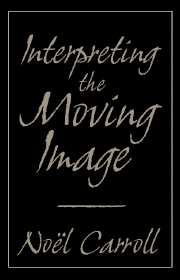Book contents
- Frontmatter
- Contents
- Foreword: Through Carroll's Looking Glass of Criticism
- Introduction
- 1 The Cabinet of Dr. Kracauer
- 2 Entr'acte, Paris and Dada
- 3 The Gold Rush
- 4 Keaton: Film Acting as Action
- 5 Buster Keaton, The General, and Visible Intelligibility
- 6 For God and Country
- 7 Lang, Pabst, and Sound
- 8 Notes on Dreyer's Vampyr
- 9 King Kong: Ape and Essence
- 10 Becky Sharp Takes Over
- 11 Interpreting Citizen Kane
- 12 The Moral Ecology of Melodrama: The Family Plot and Magnificent Obsession
- 13 Mind, Medium, and Metaphor in Harry Smith's Heaven and Earth Magic
- 14 Welles and Kafka
- 15 Nothing But a Man and The Cool World
- 16 Identity and Difference: From Ritual Symbolism to Condensation in Anger's Inauguration of the Pleasure Dome
- 17 Text of Light
- 18 Joan Jonas: Making the Image Visible
- 19 Introduction to Journeys from Berlin/1971
- 20 The Future of Allusion: Hollywood in the Seventies (and Beyond)
- 21 Back to Basics
- 22 Amy Taubin's Bag
- 23 Herzog, Presence, and Paradox
- 24 Film in the Age of Postmodernism
- Notes
- Index
9 - King Kong: Ape and Essence
Published online by Cambridge University Press: 05 June 2012
- Frontmatter
- Contents
- Foreword: Through Carroll's Looking Glass of Criticism
- Introduction
- 1 The Cabinet of Dr. Kracauer
- 2 Entr'acte, Paris and Dada
- 3 The Gold Rush
- 4 Keaton: Film Acting as Action
- 5 Buster Keaton, The General, and Visible Intelligibility
- 6 For God and Country
- 7 Lang, Pabst, and Sound
- 8 Notes on Dreyer's Vampyr
- 9 King Kong: Ape and Essence
- 10 Becky Sharp Takes Over
- 11 Interpreting Citizen Kane
- 12 The Moral Ecology of Melodrama: The Family Plot and Magnificent Obsession
- 13 Mind, Medium, and Metaphor in Harry Smith's Heaven and Earth Magic
- 14 Welles and Kafka
- 15 Nothing But a Man and The Cool World
- 16 Identity and Difference: From Ritual Symbolism to Condensation in Anger's Inauguration of the Pleasure Dome
- 17 Text of Light
- 18 Joan Jonas: Making the Image Visible
- 19 Introduction to Journeys from Berlin/1971
- 20 The Future of Allusion: Hollywood in the Seventies (and Beyond)
- 21 Back to Basics
- 22 Amy Taubin's Bag
- 23 Herzog, Presence, and Paradox
- 24 Film in the Age of Postmodernism
- Notes
- Index
Summary
Because its basic subject matter is fear, the horror film is a popular-genre vehicle that is prone to manifesting the specific anxieties that dominate the cultural context in which it was made. For example, horror films of the late seventies and early eighties – e.g., Alien (1979), The Thing (1982), Dawn of the Dead (1979), Halloween I & II (1978 & 1982), the Friday the 13th series, The Evil Dead (1983), and so on – emphasize the recurring theme of survival at a time in American history when economic circumstances have transformed the mere “bottom-line” commendation that “he/she is a survivor” into the highest badge of achievement that one can hope for. Likewise, the thirties' theme of the unjustly alienated monster, such as Frankenstein's progeny, signaled the depression anxiety of being cast out of civil society due to impoverishment; the fifties' invasion obsession reflected internal politics and the apprehension engendered there; and the early seventies' infatuation with possession and telekinesis announced a complex fantasy of powerlessness combined with infantile delusions of omnipotence during a period when it was a common experience to be enraged at being at the utter mercy of the seemingly unpredictable shifts in the national and international economy. The purpose of this article is to examine the social anxieties submerged in the classic horror film King Kong (1933), which, interestingly enough, literalizes survival metaphors that bear a noteworthy relation to those found in contemporary tales of terror.
- Type
- Chapter
- Information
- Interpreting the Moving Image , pp. 118 - 142Publisher: Cambridge University PressPrint publication year: 1998



